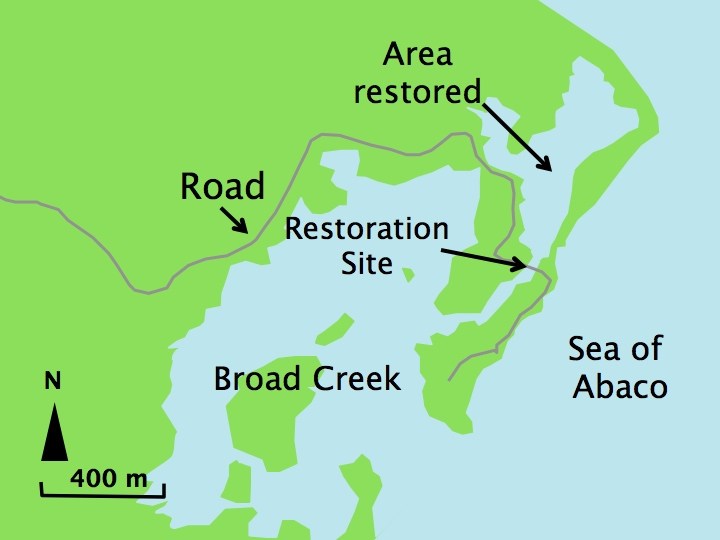Tidal creeks and mangrove wetlands are among the most important habitats in The Bahamas because of the important role they play as nurseries for juvenile and adult fishes and invertebrates. These areas provide a safe home for species such as juvenile Nassau Grouper, and crawfish before these individuals move to deeper waters as adults. Unfortunately, human impacts are responsible for significant wetland degradation across the country, including direct removal of mangroves, dredging and pollution. But perhaps the most common problem in The Bahamas is fragmentation – the result of some obstruction, typically a road, that blocks the flow of water from the ocean into the wetland. Without this flow of water, sediment builds up and the water becomes extremely hot, salty, and depleted in oxygen, creating a harsh place for animals to live. Fragmentation results in drastic changes to the environment and the loss of critical fish nurseries. The good side of segmentation is that with the proper resources it can be solved, creating more habitat for marine creatures without an negatives results.
Together in partnership with Dr. Craig Layman of Florida International University, FRIENDS has undertaken two tidal creek restorations: Broad Creek in 2010 and Cross Harbour in 2004.
Broad Creek
In October 2010, Friends of the Environment in Abaco partnered with Dr. Craig Layman and his research team from Florida International University to restore a vital tidal creek and wetland area in Abaco. Broad Creek, located just south of Marsh Harbour near Camp Abaco has been blocked for over 30 years after a road was constructed to build the camp. The restoration project entailed removing a small area of the road, installing culverts underneath the road to allow water flow, and then re-forming the road. Additionally, the historic tidal channel was recreated by selectively removing mangroves that had encroached into the channel after road construction had taken place. Within the first 24 hours of the culvert installation, several snappers and barracuda had already begun to use the previously blocked area. Dr. Layman commented, “Within just a couple of years, the successful restoration could lead to significantly increased production of snapper, including marked increases of adult snapper on nearby reefs.”
In addition to the scientific and conservation components of the restoration, Friends of the Environment used the project as a focal educational outreach initiative for students and local community members. FRIENDS coordinated presentations in the local schools and conducted field trips so that the students could actually participate in the restoration. A total of 510 students and adults assisted in reclaiming approximately 28 acres of wetlands that had been fragmented by the road. Additionally, approximately the same amount of area on the downstream side of the road was restored back to its original state by selectively removing mangroves that had filled in the historic tidal channel as a result of the blocked water flow. FRIENDS executive director Kristin Williams stated “This creek restoration is such a positive project that allows the community to improve their environment without losing anything in the process. Those who participated in the restoration will have a sense of pride knowing the long term ecological benefits of their efforts.” This project would not have been possible without the generosity of Ministry of Works, Big Cat, Adele and Timmy McDonald, Schooner Bay, and Serenity Point. The participation of FIU was made possible through a grant from the National Science Foundation (NSF). The Broad Creek Restoration Report written by Dr. Layman is available for download.
Cross Harbour
In 2006, FRIENDS partnered with Dr. Craig Layman of Florida International University to restore a fragmented wetland in Cross Harbour, South Abaco. The natural flow of the wetland had been blocked since approximately the early 1900s when a logging company installed a road to the coast to transport their materials. Culverts were placed under the road and mangroves that had encroached on the historical tidal channel were selectively removed, restoring more than 50 acres of wetlands for use as fish nurseries and wildlife habitat. The Cross Harbour Restoration Project Report written by Dr. Layman is available for download.
Original Article: Tidal Creek Restorations

